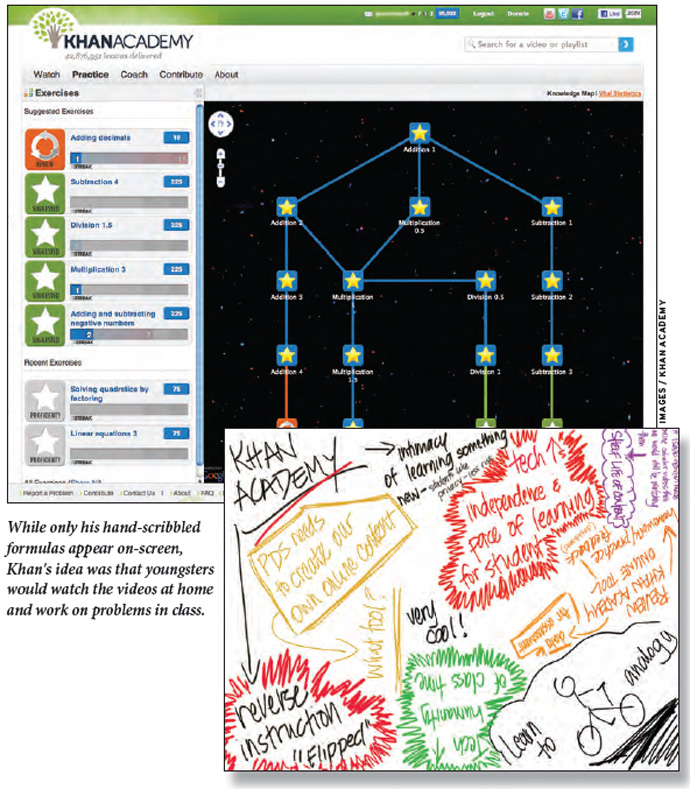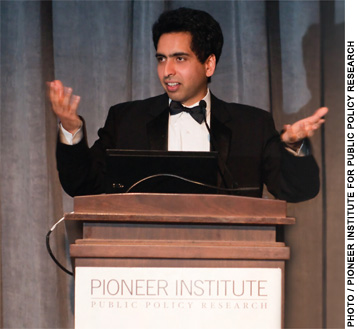 It was goal-setting day in Rich Julian’s 5th-grade class at Covington Elementary School in Los Altos, California, when I visited last fall, and Julian was asking each of his 29 students to list three math goals for the week.
It was goal-setting day in Rich Julian’s 5th-grade class at Covington Elementary School in Los Altos, California, when I visited last fall, and Julian was asking each of his 29 students to list three math goals for the week.
To become proficient at dividing a one-place number into a three-place number, a girl with blue-painted fingernails wrote in her math journal.
To become proficient in multiplying decimals, wrote a dark-haired boy. To become proficient at subtracting one four-place number from another. To become proficient in arithmetic word problems. To complete an exercise in the properties of numbers, like (4 + 9) + 5 = ? + (9 + 5).
No two youngsters seemed to have quite the same math goals because, of course, no two youngsters are quite alike when it comes to learning. That’s why Los Altos is betting the future on an online math program from Khan Academy, and why scores of other schools and districts are clamoring to include Khan Academy in their math curriculum.
For the next 45 minutes, Julian met individually with his 5th graders to refine their goals. (In November, Julian left Los Altos to become assistant principal in the Milpitas Unified School District.) Everyone else logged onto the free Khan Academy web site and called up the “module,” or math concept, that fit their goals. Some watched short video lectures embedded in the module; others worked their way through sets of practice problems. I noticed that one youngster had completed 23 modules five weeks into the school year, one had finished 30, and another was working on his 45th.
As youngsters completed one lesson, an online “knowledge map” helped them plot their next step: finish the module on adding decimals, for example, and the map suggests moving next to place values, or to rounding whole numbers, or to any of four other options.
Julian, meanwhile, tracked everyone’s progress on a computer dashboard that offers him mounds of data and alerts him when someone needs his attention. He showed me, for example, the data for a child who had been working that day on multiplying decimals. The child had watched the Khan video before answering the 1st practice problem correctly, needed a “hint” from the program on the 3rd question, got the 7th wrong after struggling with it for 350 seconds—the problem was 69.0 x 0.524—and got the 18th correct in under a minute.
But just as powerful are the data kids have on themselves. The Covington youngsters regularly pulled up an array of charts that showed them which math concepts they had mastered and which they were working on, needed to review, or were stumbling over.
The classroom buzzed with activity, and amazingly, all the buzz was about math.
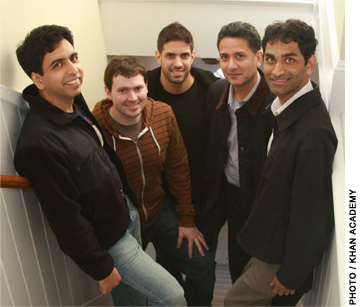
Khan’s Rise
By now, more than 1 million people have watched the online video in which Salman Khan—a charming MIT math whiz, Harvard Business School graduate, and former Boston hedge-fund analyst—explains how he began tutoring his New Orleans cousins in math by posting short lessons for them on YouTube. Other people began watching the lessons and sending Khan adulatory notes (“First time I smiled doing a derivative,” wrote one) or thanking him for explaining fractions to an autistic son.
Khan quit the hedge fund, moved to Silicon Valley, and in 2009, with funding from a constellation of technology stars (Bill Gates’s children were using the videos), launched the nonprofit Khan Academy. A year later, Mark Goines, a member of the Los Altos school board and a legendary Silicon Valley investor, introduced Khan to the district’s new superintendent. Los Altos already ranked among the best-performing districts in the state, but it had set itself a goal of improving individual achievement, and “capturing data at a granular level” on each student was proving difficult, Goines told me.
A few weeks later, in November 2010, Los Altos agreed to pilot Khan Academy with two classes of 5th graders and two classes of 7th graders and provide Khan with feedback to refine the web site and tools. By summer 2011, some 250 school districts, charter schools, and independent schools were asking to be part of the pilot—Khan chose only a dozen—and have Khan staff work with them to integrate the videos, data dashboard, and other tools into their curriculum.
Salman Khan’s short videos remain the centerpiece of Khan Academy (there already are 2,576 of them and counting). In each one, Khan’s voice describes a discrete math concept, such as solving a quadratic by factoring or interpreting inequalities, while only his hand-scribbled formulas appear on-screen. Khan’s idea was that youngsters would watch the videos at home and work on problems in class, essentially “flipping” the classroom (see “The Flipped Classroom,” What Next, Winter 2012). But teachers told me that youngsters also are using the videos as a just-in-time solution when they’re stumped on a problem in class, or to move ahead when they feel ready.
The data that the web site churns out and the site’s gaming features seem to be the real learning motivators. Youngsters become “proficient” in a concept by answering a “streak” of 10 consecutive computer-generated questions: miss one and the computer sends you back to the start. Youngsters earn “energy points” for correct answers, and badges for accomplishments as diverse as working speedily (that’s a meteorite badge) or becoming proficient in the Pythagorean theorem (that’s a moon badge).
Ted Mitchell, president of the NewSchools Venture Fund and a Khan Academy board member, told me that Khan developers “were blown away by how important” the games and badges seem to be in giving kids a sense of accomplishment and progress. Even older kids, for whom badges are ho-hum, “are instantly motivated” when they complete a streak, and the program acknowledges their accomplishment, says Brian Greenberg, who until recently was chief academic officer of Envision Schools. “What’s brilliant about Khan Academy is the instant feedback,” Greenberg told me.
Envision runs four charters in Northern California, including one that piloted Khan Academy with a small program for remedial-algebra students last summer.
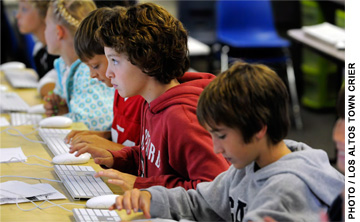
The Teaching Curve
From Covington Elementary, I dropped in on Courtney Cadwell’s 7th-grade pre-algebra class at Egan Junior High. She, like Julian, piloted Khan Academy last year. Based on that first-year success, Los Altos extended the program to all of its 5th- and 6th-grade classes, and to its 7th graders who were achieving at grade level and below.
Cadwell, a 17-year teacher who was wearing University of Texas orange for her alma mater, calls Khan just “one resource we use.” The previous night, she had assigned worksheet homework; she began the class with a textbook lesson. Math projects ringed the classroom, a reminder that Khan Academy doesn’t include project-based lessons. That night’s homework included a reading on the origin of zero: Cadwell, among others I spoke with, said Khan’s weakness is that it “is not great at helping kids conceptualize math.”
Khan’s strength became clear a few minutes later when the students opened their laptops. Cadwell strolled the room with an iPad in hand, tracking the youngsters as they moved through problems and modules, and intervening with a quick one-on-one when the data identified a student who was stumped. “I’m getting data in real time about each student instead of assuming the entire class needs intervention,” she explained afterward. Khan “lets me use my class time more wisely.”
It also means that teachers have to figure out new ways to work. “Teachers have to be willing to escape from the role of standing in front of the class” and flexible enough to group kids based on need, said Julian, who was a math coach in New York for 20 years and retains his big-city bustle.
As I watched Julian, Cadwell, and later Ruth Negash at Oakland’s Envision Academy of Arts and Technology, they seemed to be always on the move—meeting individually with children, tutoring small groups, and occasionally addressing the whole class. “I actually work harder” with Khan Academy, Julian said. “I’m up and around more, meeting with kids more.” That gives time back to students and, as Cadwell said, makes them “take ownership of their learning” by setting their own goals.
It also means a new level of classroom collaboration: youngsters can look at each other’s data and identify “coaches” among their classmates. Julian urged his 5th graders to ask the Khan program for a hint, watch a video, or ask a coach for help before coming to him. “Show him how to do it, don’t walk around the class giving answers,” he admonished would-be coaches. Pretty soon, a girl in a pink T-shirt turned to a girl in purple for coaching, and the two worked meticulously at solving 1.94 x 5.52.
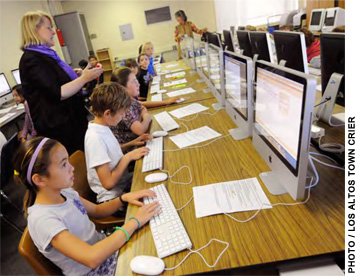
Making It Work in Oakland
Los Altos is an affluent, tech-savvy community; I next wanted to see how Khan Academy could work in an inner-city classroom. So two days later, I visited Envision Academy, a downtown Oakland charter school, and Ruth Negash, an intense 4th-year teacher with wild, curly hair and two education degrees from San Francisco State University.
In 2011, Negash taught two summer-school classes of 9th, 10th, and 11th graders who had failed Algebra I. One randomly assigned class used Khan Academy; the other was a traditional math class. The results were promising enough that Negash now is using Khan in all of her 9th-grade algebra classes.
On the day I visited, Negash started both of her classes with a minilecture on linear equations, and then had her students solve for x in 7x + 4 = 18. The classes quickly became fidgety, first as Negash explained the problem, and then as youngsters finished at different speeds. Negash had to urge them to “respect the community of learning.”
But that changed a few minutes later when the youngsters opened their computers—I had noticed the same change in Cadwell’s class—and worked on Khan Academy for the next 75 minutes. I heard an occasional groan of exasperation. “They threw a trick question at me and sent me back to the beginning,” one boy moaned when his streak was broken. But the energy now was directed toward everyone’s screen.
Although everyone in Negash’s classes had taken, and presumably passed, algebra in 8th grade, their math competence ranged from marginal to impressive. In both periods, three or four youngsters claimed a table in the hallway, where they worked silently at lessons on quadrilaterals and complementary and supplementary angles, typical geometry exercises. But other students struggled with addition and subtraction, and one quarter don’t know their multiplication tables, Negash told me. (To keep those youngsters from falling even further behind, she gives them a reference sheet with the multiplication tables on it.) Negash told both classes to work on the Khan module on solving for a variable—a continuation of her minilecture—but Khan’s online prompts were urging most youngsters to first review lessons on lower-level skills.
Some of these youngsters simply “feel safer” doing arithmetic and will move on when they’ve experienced some math “success,” Negash predicted. Other educators had similar takes: Khan “takes away a lot of the fear about math” by letting kids backfill their gaps and then move ahead at their own pace, said Sandra McGonagle, the principal of Santa Rita Elementary in Los Altos, which also is using Khan Academy in its 5th and 6th grades.
“You don’t have to worry about getting something wrong in front of the whole class,” one of Julian’s 5th graders, the girl with blue nail polish, told me.
But in Negash’s classes, the wide range of math abilities is clearly a challenge. Negash sat with one low-performing student for much of the first-period class and with three others in the second period, hoping to encourage some of that “success.” Meanwhile, other students were calling for her help. Two boys were stumped by “adjacent” in a word problem; language issues crop up “every day,” Negash said.
When Negash finally had a moment to consult her Khan dashboard at the end of second-period class, she saw that one youngster had spent 62 minutes solidly working on math, but another had spent only 14 minutes. “It’s hard to figure out a different plan for 25 kids every day,” she sighed.
Gia Truong, superintendent of Envision Schools, said Khan Academy developers had urged her to let Negash’s students “start where they were” in math and move forward. But that’s creating a conflict when some kids are so far behind, she told me: “If you do that, you might never get to the algebra standards” that California students must pass in order to graduate.
“You’re in the new paradigm, but the grading standards are in the old paradigm,” she added.
Getting to Results
Test results at both Los Altos and Envision—the only two pilots to have any results so far—suggest that Khan Academy is working. Los Altos says that among the 7th graders who used the program in 2010–11—all remedial students—41 percent scored “proficient” or “advanced” on the California Standards Test compared to 23 percent the year before. Among 5th graders, 96 percent using Khan were proficient or advanced compared to 91 percent in the rest of the district.
At Envision’s summer-school program, the youngsters in the Khan Academy class spent only half their time on algebra—the rest of their time was on lower-level math skills—and yet still slightly outscored the traditional class, which spent all of its time on algebra.
Both districts are quick to say that it’s far too early to claim success: there were only 115 youngsters in the Los Altos pilot and just 20 at Envision. “It’s enough to say this is promising; it’s not enough to say this is the future,” former Envision Schools officer Brian Greenberg said.
Most observers of the Khan experiment agree that the measure of success must be student achievement. Otherwise, “I’m not very sympathetic,” said Michael Horn of Innosight Institute. As teaching is increasingly differentiated, however, schools may need a different kind of assessment. California’s year-end test can tell which 5th graders meet the state’s math standards; it can’t tell if some of those 5th graders have progressed to trigonometry or pre-calculus, as two Los Altos kids did last year.
But several experts also suggested measuring Khan’s impact by also looking at changes in the distribution of test scores. Khan Academy isn’t likely to close the learning gap because some kids, freed from the teach-to-the-middle plod of the usual classroom, gallop ahead. But Khan would be a success if low-performing kids move ahead too and “shift the bell curve to the right,” said the NewSchool Venture Fund’s Ted Mitchell.
Some other Khan watchers gave a surprisingly strong endorsement to such measures as student engagement and self-confidence, and to soft skills like goal setting and teamwork. “I don’t look at it as just based on the data,” said Mark Goines, the Los Altos school board member whose high-tech background (he helped develop and run TurboTax for Intuit, Inc.) suggests a fine reading of the data. “The kids seem to be happy about learning. That makes me excited,” he said.
What about increasing class size, I asked: Should Khan’s success be measured in part on its ability to increase teacher productivity? In elementary schools, where students generally spend the day with one teacher, increasing class size because of Khan would mean bigger classes in every other subject, too. And Goines, who said he has viewed “hundreds” of online programs, cautioned that there aren’t any comparable products in other subjects, especially in writing.
A fear among advocates of online learning is that slow learners will be abandoned in front of a computer, and a large classroom increases those chances. “It would then become a babysitting tool,” said McGonagle, Santa Rita’s principal.
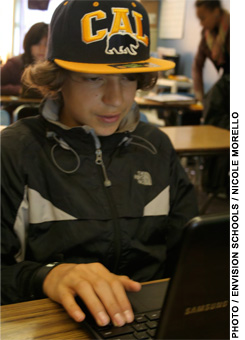
Blending Khan
Finally, I asked for “takeaways” from the Khan Academy experience. Greenberg told me that it’s more important that teachers be “nimble” and “entrepreneurial” than that they be tech wizards. All three teachers said they felt comfortable with technology, but that, more importantly, they were risk-takers. Even before she began piloting Khan Academy, Cadwell asked her PTA to buy classroom laptops for the youngsters in her remedial math class. “I figured if I could get them onto some practice sites, I’d figure things out from there,” she said.
Santa Rita’s McGonagle said it was “crucial” to have pilot teachers like Cadwell who can act as avatars for the rest of the district as it expands its blended learning. Cadwell is mentoring other Los Altos teachers this year. They “don’t need training as much as they need time” with the program, she told me (the data are fairly easy to use, but she and Julian asked Khan’s engineers for so much of it that both say they don’t always use it all).
The schools, meanwhile, are holding rollout meetings for parents and are urging parents to join the web site, where they can see the same data as the teachers, including whether little Bobby is really working on math up in his bedroom as he says he is. “It’s not just training the teachers; it’s training the community,” Goines said.
That training shouldn’t end with just learning to manipulate the data, though. It also means learning how teachers can use their time differently, how to work with youngsters who have different abilities, and how to blend Khan into the curriculum, not substitute for it, everyone told me. Cadwell and Negash said that they find gaps in the Khan curriculum, and that it isn’t completely aligned with either California or core-curriculum standards, although Khan is adding lessons to fill the holes.
“You can’t just put a kid down in front of a computer,” Goines said, although the kids I saw in Julian’s, Cadwell’s, and Negash’s classes sure seemed to enjoy it.
June Kronholz is an Education Next contributing editor.
This article appeared in the Spring 2012 issue of Education Next. Suggested citation format:
Kronholz, J. (2012). Can Khan Move the Bell Curve to the Right? Math instruction goes viral. Education Next, 12(2), 16-22.


